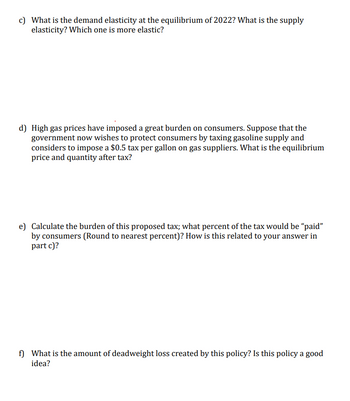Gas prices have become remarkably high since the beginning of the year 2022. On June 9th, 2022, a gallon of gasoline costs 4.06 dollars---almost 400% higher than it was on the same date of 2020 ($1.1 per gallon). We will apply what we learned about demand and supply to take a look at gas prices. Suppose that in 2020, the worldwide daily supply function of gasoline is given by Qs(p) = 150 + 100p. The daily demand of gasoline in 2020 is: QD (P) 300 - 50p, where p is the price per gallon of gasoline and q is in the unit of million gallons. a) Solve for the market equilibrium for daily gasoline in 2020. What is the equilibrium price? What is the equilibrium quantity? b) In the summer of 2022, people started to return to offices and to traveling. This leads to an outward shift of the demand. Suppose now that the demand becomes: QD(P) = 700-50p. In the meantime, the supply-chain problems and the Ukrainian war has led to an inward shift of the supply. Suppose the supply becomes: Qs(p) = 100 + 100p. What is the new equilibrium price and what is the new equilibrium quantity?
Gas prices have become remarkably high since the beginning of the year 2022. On June 9th, 2022, a gallon of gasoline costs 4.06 dollars---almost 400% higher than it was on the same date of 2020 ($1.1 per gallon). We will apply what we learned about demand and supply to take a look at gas prices. Suppose that in 2020, the worldwide daily supply function of gasoline is given by Qs(p) = 150 + 100p. The daily demand of gasoline in 2020 is: QD (P) 300 - 50p, where p is the price per gallon of gasoline and q is in the unit of million gallons. a) Solve for the market equilibrium for daily gasoline in 2020. What is the equilibrium price? What is the equilibrium quantity? b) In the summer of 2022, people started to return to offices and to traveling. This leads to an outward shift of the demand. Suppose now that the demand becomes: QD(P) = 700-50p. In the meantime, the supply-chain problems and the Ukrainian war has led to an inward shift of the supply. Suppose the supply becomes: Qs(p) = 100 + 100p. What is the new equilibrium price and what is the new equilibrium quantity?
Chapter1: Making Economics Decisions
Section: Chapter Questions
Problem 1QTC
Related questions
Question
100%

Transcribed Image Text:Problem 2. Gas price
Gas prices have become remarkably high since the beginning of the year 2022. On June 9th,
2022, a gallon of gasoline costs 4.06 dollars---almost 400% higher than it was on the same
date of 2020 ($1.1 per gallon). We will apply what we learned about demand and supply to
take a look at gas prices.
Suppose that in 2020, the worldwide daily supply function of gasoline is given by
Qs(p) = 150 + 100p.
The daily demand of gasoline in 2020 is:
QD(P) = 300 - 50p,
where p is the price per gallon of gasoline and q is in the unit of million gallons.
a) Solve for the market equilibrium for daily gasoline in 2020. What is the equilibrium
price? What is the equilibrium quantity?
b) In the summer of 2022, people started to return to offices and to traveling. This
leads to an outward shift of the demand. Suppose now that the demand becomes:
QD (P) = 700 - 50p.
In the meantime, the supply-chain problems and the Ukrainian war has led to an
inward shift of the supply. Suppose the supply becomes:
Qs(p) = 100 + 100p.
What is the new equilibrium price and what is the new equilibrium quantity?
Expert Solution
This question has been solved!
Explore an expertly crafted, step-by-step solution for a thorough understanding of key concepts.
This is a popular solution!
Trending now
This is a popular solution!
Step by step
Solved in 3 steps

Follow-up Questions
Read through expert solutions to related follow-up questions below.
Follow-up Question
Follow up question regarding elasticities and taxes.

Transcribed Image Text:c) What is the demand elasticity at the equilibrium of 2022? What is the supply
elasticity? Which one is more elastic?
d) High gas prices have imposed a great burden on consumers. Suppose that the
government now wishes to protect consumers by taxing gasoline supply and
considers to impose a $0.5 tax per gallon on gas suppliers. What is the equilibrium
price and quantity after tax?
e) Calculate the burden of this proposed tax; what percent of the tax would be "paid"
by consumers (Round to nearest percent)? How is this related to your answer in
part c)?
f) What is the amount of deadweight loss created by this policy? Is this policy a good
idea?
Solution
Knowledge Booster
Learn more about
Need a deep-dive on the concept behind this application? Look no further. Learn more about this topic, economics and related others by exploring similar questions and additional content below.Recommended textbooks for you


Principles of Economics (12th Edition)
Economics
ISBN:
9780134078779
Author:
Karl E. Case, Ray C. Fair, Sharon E. Oster
Publisher:
PEARSON

Engineering Economy (17th Edition)
Economics
ISBN:
9780134870069
Author:
William G. Sullivan, Elin M. Wicks, C. Patrick Koelling
Publisher:
PEARSON


Principles of Economics (12th Edition)
Economics
ISBN:
9780134078779
Author:
Karl E. Case, Ray C. Fair, Sharon E. Oster
Publisher:
PEARSON

Engineering Economy (17th Edition)
Economics
ISBN:
9780134870069
Author:
William G. Sullivan, Elin M. Wicks, C. Patrick Koelling
Publisher:
PEARSON

Principles of Economics (MindTap Course List)
Economics
ISBN:
9781305585126
Author:
N. Gregory Mankiw
Publisher:
Cengage Learning

Managerial Economics: A Problem Solving Approach
Economics
ISBN:
9781337106665
Author:
Luke M. Froeb, Brian T. McCann, Michael R. Ward, Mike Shor
Publisher:
Cengage Learning

Managerial Economics & Business Strategy (Mcgraw-…
Economics
ISBN:
9781259290619
Author:
Michael Baye, Jeff Prince
Publisher:
McGraw-Hill Education